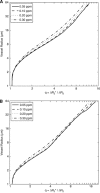The influence of noise on BOLD-mediated vessel size imaging analysis methods
- PMID: 23942365
- PMCID: PMC3851896
- DOI: 10.1038/jcbfm.2013.141
The influence of noise on BOLD-mediated vessel size imaging analysis methods
Abstract
Vessel size imaging (VSI) is a magnetic resonance imaging (MRI) technique that aims to provide quantitative measurements of tissue microvasculature. An emerging variation of this technique uses the blood oxygenation level-dependent (BOLD) effect as the source of the imaging contrast. Gas challenges have the advantage over contrast injection techniques in that they are noninvasive and easily repeatable because of the fast washout of the contrast. However, initial results from BOLD-VSI studies are somewhat contradictory, with substantially different estimates of the mean vessel radius. Owing to BOLD-VSI being an emerging technique, there is not yet a standard processing methodology, and different techniques have been used to calculate the mean vessel radius and reject uncertain estimates. In addition, the acquisition methodology and signal modeling vary from group to group. Owing to these differences, it is difficult to determine the source of this variation. Here we use computer modeling to assess the impact of noise on the accuracy and precision of different BOLD-VSI calculations. Our results show both potential overestimates and underestimates of the mean vessel radius, which is confirmed with a validation study at 3T.
Figures



References
-
- Dennie J, Mandeville JB, Boxerman JL, Packard SD, Rosen BR, Weisskoff RM. NMR imaging of changes in vascular morphology due to tumor angiogenesis. Magn Reson Med. 1998;40:793–799. - PubMed
-
- Jensen JH, Chandra R. MR imaging of microvasculature. Magn Reson Med. 2000;44:224–230. - PubMed
-
- Tropres I, Grimault S, Vaeth A, Grillon E, Julien C, Payen JF, et al. Vessel size imaging. Magn Reson Med. 2001;45:397–408. - PubMed
-
- Jochimsen TH, Ivanov D, Ott DVM, Heinke W, Turner R, Moller HE, et al. Whole-brain mapping of venous vessel size in humans using the hypercapnia-induced BOLD effect. Neuroimage. 2010;51:765–774. - PubMed
-
- Prinster A, Pierpaoli C, Turner R, Jezzard P. Simultaneous measurement of Delta R2 and Delta R2* in cat brain during hypoxia and hypercapnia. Neuroimage. 1997;6:191–200. - PubMed
Publication types
MeSH terms
Substances
LinkOut - more resources
Full Text Sources
Other Literature Sources
Medical

